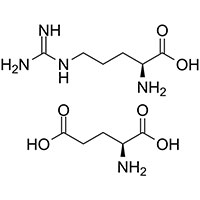Synonyms
Arginine glutamate
EINECS 224-350-0
Glutargin
Argimate
L-Glutamic acid, compd. with L-arginine (1:1)
L-Arginine - L-glutamic acid (1:1)
L-Arginine glutamate
S(+)-2-Amino-5-guanidinopentanoic acid L-glutamate salt
Glutepar
L-Arginine L-glutamate
L-Glutamic Acid compd. with L-Arginine (1:1)
MFCD06408000
L-Arginine, compd. with L-glutamic acid (1:1)
Ginamate
Product Description
Introduction:
L-Arginine L-Glutamate is a significant chemical compound with diverse applications in the chemical
industry. This product introduction aims to provide an overview of L-Arginine L-Glutamate, covering its
raw materials, production process, market trends, and the current status of amino acids in the
industry.
Raw Materials:
L-Arginine L-Glutamate is synthesized using L-arginine and L-glutamic acid as the primary raw materials.
L-arginine, an essential amino acid, and L-glutamic acid, a nonessential amino acid, serve as the
precursors for the synthesis of L-Arginine L-Glutamate.
Production Process:
The production process of L-Arginine L-Glutamate involves the following steps:
Step 1: Reaction - L-arginine and L-glutamic acid are combined and reacted under controlled conditions,
typically in an aqueous solution or appropriate solvent, to form L-Arginine L-Glutamate. The reaction
may involve the addition of suitable catalysts or reagents to facilitate the formation of the
compound.
Step 2: Purification and refinement - The resulting L-Arginine L-Glutamate is purified and refined using
techniques such as filtration, crystallization, and chromatography to achieve the desired level of
purity.
Market Trends:
The market demand for L-Arginine L-Glutamate has been steadily increasing due to its diverse
applications across various industries. Here are some key market trends:
Pharmaceuticals: L-Arginine L-Glutamate is used in the pharmaceutical industry. It is often included in
formulations targeting cardiovascular health and immune function. L-Arginine is known to support healthy
blood flow, while L-glutamate plays a role in immune modulation.
Food and Beverage: L-Arginine L-Glutamate finds applications in the food and beverage industry. It is
used as a flavor enhancer and may be added to certain food products to improve taste and
palatability.
Current Status of Amino Acids:
Amino acids play a crucial role in various sectors, including pharmaceuticals, food additives, animal
nutrition, and agriculture. They are the building blocks of proteins and have essential functions in the
human body. L-arginine and L-glutamic acid are among the important amino acids used in various
industries.
Conclusion:
L-Arginine L-Glutamate, derived from the combination of L-arginine and L-glutamic acid, holds
significant value in the chemical industry. Its production involves the reaction of the two amino acids,
followed by purification and refinement. The market demand for L-Arginine L-Glutamate is driven by its
applications in the pharmaceutical industry for cardiovascular health and immune function, as well as
its usage in the food and beverage industry as a flavor enhancer. Amino acids continue to be essential
components in various industries, contributing to advancements in chemical applications and human
health.





